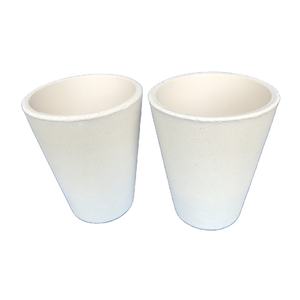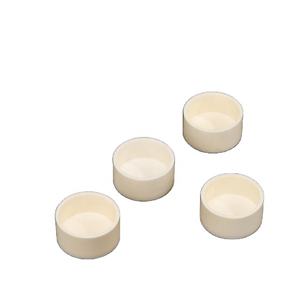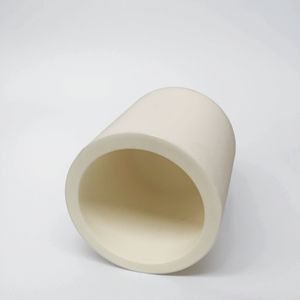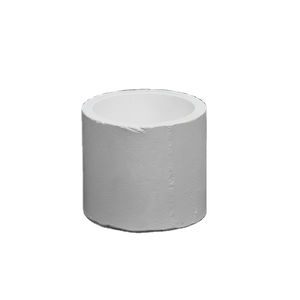Professional industry ceramic supplier, silicon nitride, silicon carbide, aluminum nitride and any other kinds of ceramics.
PRODUCT PARAMETERS
Description
Overview of Alumina Ceramic TGA Crucible with Lid for Testing Instrument
Alumina Ceramic TGA Crucible with Lid for Testing Instrument are specialized containers designed for withstanding extremely high temperatures in laboratory and industrial settings. They are essential for processes such as melting, calcining, and heat-treating a wide variety of materials, including metals, glasses, and chemicals. Our crucibles are engineered for superior thermal stability and chemical resistance, ensuring purity and reliability in the most demanding applications.
Features of Alumina Ceramic TGA Crucible with Lid for Testing Instrument
-
Exceptional Thermal Shock Resistance: Withstands rapid temperature changes without cracking, ensuring durability and a long service life.
-
High-Temperature Stability: Maintains structural integrity at extreme temperatures, often exceeding 1500°C.
-
Excellent Chemical Inertness: Resists corrosion and reaction with molten metals, acids, and aggressive chemical fluxes.
-
High Purity & Low Contamination: Manufactured from premium materials to prevent sample contamination during sensitive processes.
-
Optimized Thermal Properties: Designed for efficient heat transfer and consistent performance in furnace environments.
-
Robust Mechanical Strength: Offers good resistance to physical impact and abrasion during handling and use.
Specifications of Alumina Ceramic TGA Crucible with Lid for Testing Instrument
Alumina ceramic TGA crucibles with lids are essential tools for thermal analysis instruments. These crucibles hold samples during testing. They must withstand extreme conditions. Alumina ceramic is a popular choice. It offers excellent high-temperature performance. These crucibles resist temperatures far beyond 1500°C. This makes them suitable for demanding TGA applications. The material also shows good chemical stability. It does not react easily with most samples. This ensures test results remain accurate. High purity alumina is crucial. Impurities can interfere with measurements. These crucibles are typically over 99% pure alumina. This purity minimizes background effects.
The crucible design is important. Standard sizes fit common TGA instruments. Crucibles come in various diameters and heights. Matching the crucible size to the instrument is necessary. The accompanying lid is vital. It helps contain the sample. It prevents sample loss during heating. Lids also protect the instrument from contamination. Crucibles and lids are precisely shaped. They fit together snugly. This ensures consistent results run after run. Surface smoothness matters. A smooth interior surface prevents sample sticking. It allows for easy cleaning between tests.
These crucibles are very durable. They handle repeated heating and cooling cycles well. This durability provides good value. Users get many tests from each crucible. Alumina ceramic is also inert. It does not release gases when heated. This avoids adding mass changes not from the sample itself. The material properties make these crucibles reliable. They deliver consistent performance. Researchers trust them for precise thermal stability measurements. They are widely used in labs analyzing materials like polymers, chemicals, and pharmaceuticals. Proper crucible selection impacts data quality significantly.
Applications of Alumina Ceramic TGA Crucible with Lid for Testing Instrument
Alumina ceramic TGA crucibles with lids are essential tools for thermal analysis. These crucibles are made from high-purity alumina. This material offers excellent properties for demanding lab tests. They are used inside testing instruments called thermogravimetric analyzers, or TGAs. TGA instruments measure how a material’s weight changes as it is heated. The crucible holds the sample material during this heating process.
The alumina ceramic construction gives these crucibles key advantages. They withstand very high temperatures. This is critical because TGA tests often involve heating samples to over 1000 degrees Celsius. Alumina ceramic is also chemically inert. It does not react with most samples. This ensures test results are accurate. The ceramic material is stable and does not add weight or interfere.
The included lid is an important part. The lid helps contain the sample securely within the crucible. This prevents sample loss, especially for powders or volatile materials. The lid also helps control the atmosphere around the sample. Researchers can run tests under specific gas environments like nitrogen or air. The lid aids in maintaining this atmosphere directly around the sample material.
These crucibles find use in many different TGA applications. They are perfect for studying material decomposition. This includes understanding when and how materials break down when heated. They are used for oxidation stability tests. Researchers see how materials react with oxygen at high heat. Measuring ash content is another key application. This determines the non-combustible residue left after burning a sample. These crucibles help analyze moisture or solvent content too. The weight loss shows how much volatile material evaporates.
Using alumina ceramic TGA crucibles with lids provides reliable results. Their high-temperature capability and inert nature make them dependable. The lid adds functionality for sample security and atmosphere control. These crucibles are a fundamental component for accurate thermal analysis.
Company Profile
Tanki New Materials Co.Ltd. focus on the research and development, production and sales of ceramic products, serving the electronics, ceramics, chemical and other industries. Since its establishment in 2015, the company has been committed to providing customers with the best products and services, and has become a leader in the industry through continuous technological innovation and strict quality management.
Our products includes but not limited to Aerogel, Aluminum Nitride, Aluminum Oxide, Boron Carbide, Boron Nitride, Ceramic Crucible, Ceramic Fiber, Quartz Product, Refractory Material, Silicon Carbide, Silicon Nitride, ect. please feel free to contact us.

Payment Methods
T/T, Western Union, Paypal, Credit Card etc.
Shipment Methods
By air, by sea, by express, as customers request.
5 FAQs of Alumina Ceramic TGA Crucible with Lid for Testing Instrument
What exactly is an alumina ceramic TGA crucible? It’s a small, bowl-shaped container made from alumina ceramic material. It comes with a matching lid. This setup is specifically designed for use inside Thermogravimetric Analysis instruments. These instruments measure how a material’s weight changes as temperature changes.
Why use alumina ceramic for these crucibles? Alumina ceramic is a special material. It handles very high heat well. It doesn’t easily react with most chemicals. It stays strong even at high temperatures. These properties are vital for TGA testing. The crucible must not change itself during the test. It needs to accurately hold the sample.
Why is a lid important? The lid is crucial. It helps contain the sample within the crucible. This prevents tiny sample particles from blowing away. That could happen due to gas flow inside the instrument. It also helps control the atmosphere around the sample. This is important for certain tests.
Can I reuse an alumina ceramic crucible? Yes, usually you can reuse them. They are quite durable. But, it depends on the test conditions and the sample. Some samples might react with the crucible surface. This could leave residues. Always inspect the crucible carefully after each use. Check for damage or leftover material. Clean it thoroughly before using it again. This ensures accurate results next time.
How do I clean and maintain them? Cleaning is important. Use mild methods first. Try gentle scrubbing with a soft brush under running water. For tougher residues, soaking in a mild acid solution might help. Avoid strong chemicals or abrasive cleaning tools. They can scratch the surface. Handle the crucible carefully. Alumina ceramic is hard but can crack if dropped or hit hard. Store them safely to prevent chips or cracks.
REQUEST A QUOTE
RELATED PRODUCTS

Pyrolytic Boron Nitride Crucible Pbn Ceramic Crucible Mbe Crucible

Lab glassware Ceramics Core Crucible 30ml 40ml 60ml G1 G2 G3 G4 G5 Crucible Filter Sand Core Crucible

100ml Factory Supply Zirconium Ceramic Crucible/zirconia Mill Pot

Economical Glazed Ceramic/Porcelain Crucibles with Glazing Lids High Wall Ceramic Crucible

Dental Laboratory Hooded Casting Quartz Ceramic Crucible



